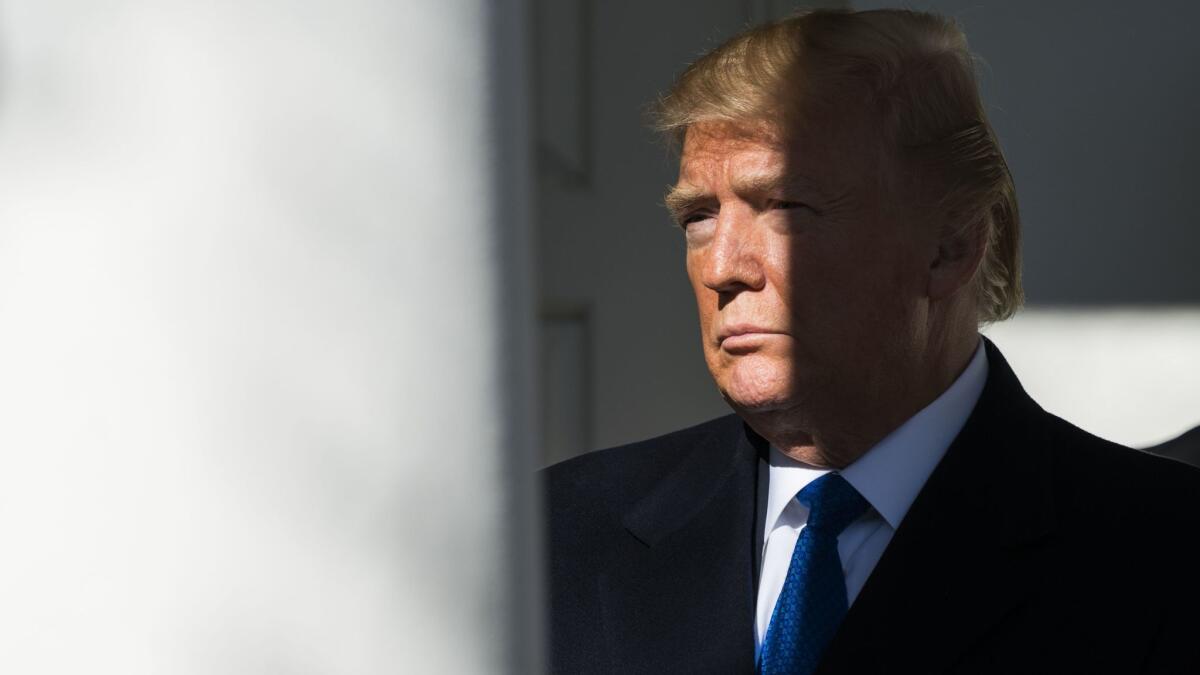Editorial: A year in, Trump distracts while his appointees sledgehammer the government

With nearly every utterance, Donald Trump affirms the conclusion we reached two years ago that he is temperamentally and intellectually unfit to serve as president of the United States. But there he is, a year after his inauguration, waging a war of words with the world from behind the Resolute desk in the Oval Office. He has denigrated fellow citizens and international allies; threatened nuclear war; undermined public faith in the judiciary, Congress, and the media; found some “very fine people” at a gathering of neo-Nazis; and dispensed utterly with the idea of presidential gravitas.
In fact, there’s been so much public attention paid to his tweets, to his character and temperament, to the ongoing investigations into how he came to power, that close scrutiny has sometimes lagged into what this administration has actually done.
In brief, it’s bad. Here’s a quick look.
Internationally, Trump has only partly translated his narrow and historically fraught “America first” campaign rhetoric into policy. Despite some early drama over NATO’s budget, Trump has followed a fairly traditional policy of supporting the postwar alliance. His oft-stated desire for better relations with Vladimir Putin stalled over broad condemnation of Russian meddling in the 2016 election, and Trump signed legislation imposing sanctions on Russia (with some reservations) and also approved selling lethal weapons to help Ukraine fend off pro-Russia separatists.
Lies and provocations and Twitter rants are only one part of this presidency.
The president no doubt deserves some of the credit for routing Islamic State from strongholds in Iraq and Syria, although those victories were built on decisions made by military planners during the Obama administration.
But Trump has rattled sabers with North Korea (bragging about the size of his “nuclear button”), threatened the international deal to limit Iranian nuclear development, and withdrawn the U.S. from a Pacific Rim trade pact (and now has his sights set on NAFTA, a function of his ill-advised protectionist views of trade). He has been less than supportive of the United Nations, withdrawing the U.S. from UNESCO and cutting aid to the agency that works with Palestinian refugees, among other things. His decision to recognize Jerusalem as Israel’s capital seems certain to damage the prospects for peace in the region.
Domestically, Trump has embraced a scorched-earth attitude toward regulations on businesses. He has failed to fill positions across his administration while simultaneously appointing foxes to oversee such henhouses as the Environmental Protection Agency, the Department of Education and the Consumer Financial Protection Bureau. He has sought to weaken worker and consumer protections, to end policies aimed at reducing greenhouse gas emissions, to shrink public lands (including slashing the size of national monuments), while seeking to open more federally controlled land and waters to oil, gas and other exploitative industries. His nationalistic opposition to immigration, his decision to end the Deferred Action for Childhood Arrivals program and his draconian approach to immigration enforcement have made a broken system worse.
Trump inherited an economy that, while growing slowly, was fundamentally strong, with steadily rising consumer and business confidence, an epic bull run in the stock market, low unemployment, rebounding median incomes and modestly improving wages. Those trends have continued on his watch, boosted by his business-friendly agenda, but so has the grossly unequal distribution of gains that has sustained wide income inequality. Trump’s policies have exacerbated those problems — the tax cut he championed disproportionately favored high-income families and businesses, and his administration’s relentless attacks on the Affordable Care Act helped cause millions more Americans to go uninsured in 2017 — the biggest increase since the ACA passed in 2010.
Trump has been successful in quietly reshaping the judiciary. The Senate has confirmed 23 judicial nominees, including Supreme Court Justice Neil M. Gorsuch. Although the American Bar Assn. rated a handful of the nominees not qualified, most are the sort of well-credentialed conservative jurists that any Republican president would be likely to appoint. But Trump has also pushed a racially tinged and outmoded view of law and order, which has played out with directives by Atty. Gen. Jeff Sessions to end federal oversight of troubled police departments, endorse asset forfeiture from people not convicted of crimes and reverse Obama administration sentencing reforms by seeking harsher sentences for drug crimes.
So where is the nation after the first year of President Trump? Paying attention, in some cases, to the wrong things. Lies and provocations and Twitter rants are only one part of this presidency. Another is the ongoing effort to dismantle not just government agencies but the mission of government itself.
Follow the Opinion section on Twitter @latimesopinion or Facebook
More to Read
A cure for the common opinion
Get thought-provoking perspectives with our weekly newsletter.
You may occasionally receive promotional content from the Los Angeles Times.










